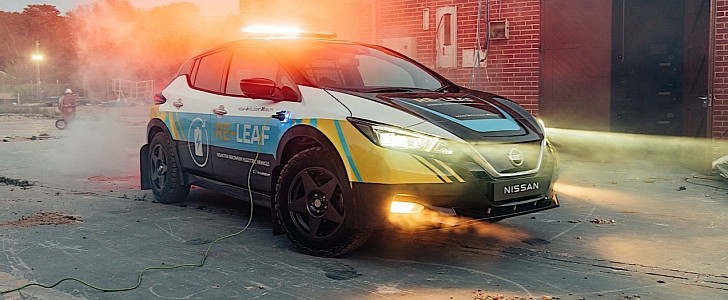The arrival of the electric vehicle opened up a new world of possibilities. Aside from the fact EVs are in theory better for the environment, they could also be mobile storage devices for electricity.
A number of carmakers, especially the Japanese and French ones, are looking into ways to turn electric vehicles into an aid of sorts for the power grid, when demand is to high.
Vehicle-to-grid is how they call this, and the Nissan Leaf became in late 2018 the first EV approved to feed electricity back into the grid. It happened in Germany, while in the Portuguese Madeira Islands and on the French island of Belle-Île-en-Mer, Nissan’s partner Renault is working on a similar integration.
But an electric vehicle could be used for much more than just feed electricity back into the grid. It could be used, for instance, to provide power in areas affected by natural or some other type of disasters. Enter the Re-Leaf concept, a modified Nissan EV meant to be used in exactly such conditions.
Based on a regular production Leaf Tekna, the car comes with several modifications meant to make it suitable for use in disaster areas. The most important of them are the weatherproof plug sockets mounted directly to the exterior of the vehicle.
These can be used to plug 110 to 230-volt devices, and quite a number of them: the 62 kWh battery fitted on the car is large enough to power the average UK household for around six days, as per Nissan’s claims. These devices can be anything from a jack hammer to 100 watt LED floodlights.
Additionally, the car’s ride height has been raised by 70 mm to 225 mm, and there is a custom sump guard to protect the car’s floor pan. Re-Leaf comes with wider tracks (+90 mm front / +130 mm rear), custom wheel arches, mud flaps and all-terrain tires wrapped on 17-inch motorsport wheels. Inside, the rear seats are gone, making room for storage space for needed equipment.
The carmaker did not reveal any plans to make the Re-Leaf some type of specialized production car.
Vehicle-to-grid is how they call this, and the Nissan Leaf became in late 2018 the first EV approved to feed electricity back into the grid. It happened in Germany, while in the Portuguese Madeira Islands and on the French island of Belle-Île-en-Mer, Nissan’s partner Renault is working on a similar integration.
But an electric vehicle could be used for much more than just feed electricity back into the grid. It could be used, for instance, to provide power in areas affected by natural or some other type of disasters. Enter the Re-Leaf concept, a modified Nissan EV meant to be used in exactly such conditions.
Based on a regular production Leaf Tekna, the car comes with several modifications meant to make it suitable for use in disaster areas. The most important of them are the weatherproof plug sockets mounted directly to the exterior of the vehicle.
These can be used to plug 110 to 230-volt devices, and quite a number of them: the 62 kWh battery fitted on the car is large enough to power the average UK household for around six days, as per Nissan’s claims. These devices can be anything from a jack hammer to 100 watt LED floodlights.
Additionally, the car’s ride height has been raised by 70 mm to 225 mm, and there is a custom sump guard to protect the car’s floor pan. Re-Leaf comes with wider tracks (+90 mm front / +130 mm rear), custom wheel arches, mud flaps and all-terrain tires wrapped on 17-inch motorsport wheels. Inside, the rear seats are gone, making room for storage space for needed equipment.
The carmaker did not reveal any plans to make the Re-Leaf some type of specialized production car.

















